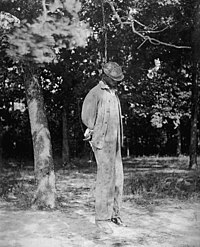
Back Lynch Afrikaans إعدام دون محاكمة Arabic لنشيه ARZ Linç Azerbaijani لینچ ائدمک AZB Суд Лінча Byelorussian Линчуване Bulgarian मॉब लिंचिंग Bihari Linchañ Breton Linxament Catalan

| Part of a series on |
| Discrimination |
|---|
 |
Lynching is an extrajudicial killing by a group. It is most often used to characterize informal public executions by a mob in order to punish an alleged transgressor, punish a convicted transgressor, or intimidate people. It can also be an extreme form of informal group social control, and it is often conducted with the display of a public spectacle (often in the form of a hanging) for maximum intimidation.[1] Instances of lynchings and similar mob violence can be found in all societies.[2][3][4][5][6]
In the United States, where the word for "lynching" likely originated, lynchings of African Americans became frequent in the South during the period after the Reconstruction era, especially during the nadir of American race relations.[7]
- ^ Wood, Amy Louise (2009). Rough Justice: Lynching and American Society, 1874–1947. North Carolina University Press. ISBN 9780807878118. OCLC 701719807.
- ^ Berg, Manfred; Wendt, Simon (2011). Globalizing Lynching History: Vigilantism and Extralegal Punishment from an International Perspective. Palgrave Macmillan. ISBN 978-0-230-11588-0.
- ^ Huggins, Martha Knisely (1991). Vigilantism and the state in modern Latin America : essays on extralegal violence. New York: Praeger. ISBN 0275934764. OCLC 22984858.
- ^ Thurston, Robert W. (2011). Lynching : American mob murder in global perspective. Burlington, VT: Ashgate. ISBN 9781409409083. OCLC 657223792.
- ^ Pfeifer, Michael J, ed. (February 15, 2017). Global Lynching and Collective Violence: Volume 1: Asia, Africa, and the Middle East. University of Illinois Press. doi:10.5406/illinois/9780252040801.001.0001. ISBN 978-0-252-09930-4.
- ^ Pfeifer, Michael J, ed. (2017). Global Lynching and Collective Violence: Volume 2: The Americas and Europe. University of Illinois Press. doi:10.5406/j.ctt1vjqrpr. ISBN 978-0-252-04138-9. JSTOR 10.5406/j.ctt1vjqrpr.
- ^ Hill, Karlos K. (February 28, 2016). "21st Century Lynchings?". Cambridge Blog. Cambridge University Press. Retrieved July 3, 2020.